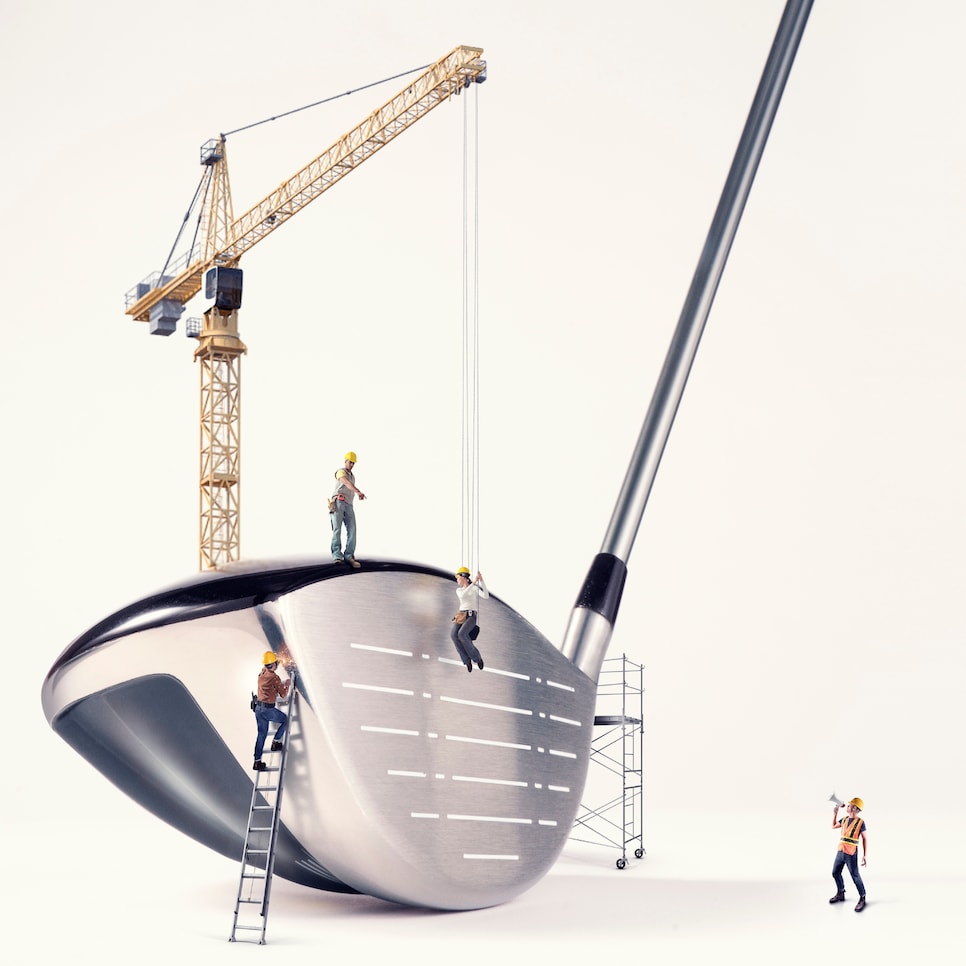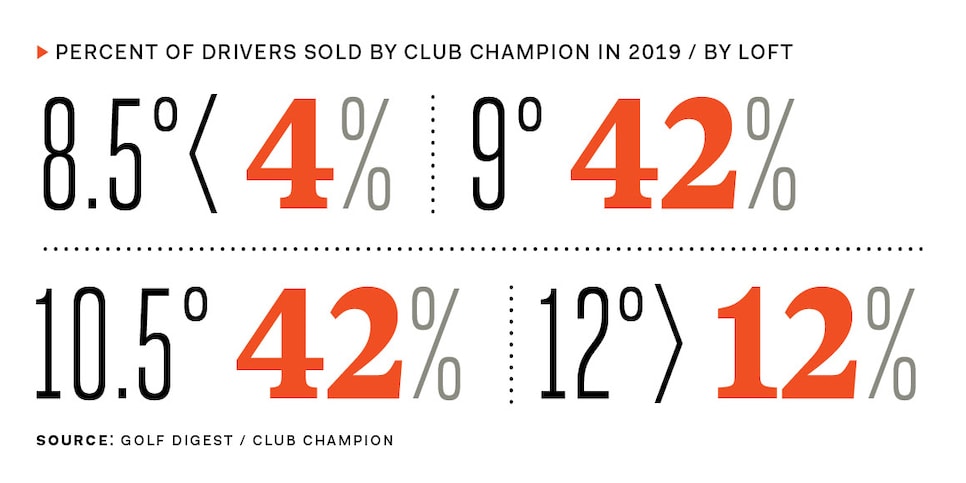Equipment
Golf equipment truths: Why you should rethink your driver loft

Jin-Young Ko, the No. 1-ranked player on the LPGA Tour, swings the driver nearly 30 miles per hour slower than Brooks Koepka, the No. 1 male player in the world. Yet Ko uses a driver with 9 degrees of loft—1.5 degrees less than Koepka. What gives? Aren’t golfers with slower swing speeds supposed to use drivers with more loft?
That’s not necessarily the case anymore.
Sixteen years ago, Golf Digest presented compelling evidence that average golfers needed to use drivers with more loft to maximize distance—sometimes as much as 12, 14 or 16 degrees. But because of changing driver designs and changing swings, the opposite might be true today. In an exclusive Golf Digest study done in conjunction with Club Champion, the leading national clubfitting chain, players with swing speeds of 80 to 100 miles per hour consistently hit the driver farther when it had a lower loft, not a higher one. (The average male-golfer swing speed is in the mid-90s.) Participants in our tests achieved more distance when they used drivers with less than 10 degrees of loft.
In fact, swings often got the most distance with driver lofts at 9 degrees or less. (It’s still true that golfers who swing less than 80 mph would likely benefit from using drivers with 11 degrees of loft or higher.) Lower lofts can provide more energy transfer at impact because there’s less of an oblique angle. It’s why your 7-iron flies farther than your 8-iron.
In our test, drivers with less loft consistently produced more ball speed, even for low swing-speed golfers (3.2 mph more compared to the 10.5 and 12-degree drivers).
What’s changing? One big reason is the concept of attack angle, or the way the clubhead approaches the ball as it moves toward impact. With a slightly upward angle of attack—rather than downward—a lower-lofted driver can produce better results. Ko’s upward angle of attack is typical of the LPGA Tour. According to TrackMan data, the average attack angle on the LPGA Tour is distinctly upward at +3 degrees. On the PGA Tour, it’s relatively downward at -1.3. This is why some LPGA players could benefit from the lower-lofted drivers used by PGA Tour players swinging 20 or even 30 mph faster. A recent study by TrackMan revealed that by changing the attack angle on your driver swing from downward to significantly upward, you can boost distance by 23 yards— and that’s not for a tour-level swing; that’s at a relatively average speed of 90 mph.
It’s the modern secret to distance, says Nick Sherburne, founder of Club Champion. “Even though you should always get fi t, don’t assume if you’re an average golfer that lofting up is always better,” he says. “Golf balls and the center of gravity on drivers have changed so much since 2003 that playing a higher loft isn’t needed anymore to create the ideal distance recipe of high launch and low spin. With the advent of launch monitors, players are learning to hit up on the ball to maximize distance. Almost every group in the test had a positive attack angle. Twenty years ago, even 10, we never saw so many positive attack angles.”
With an upward angle of attack, a player creates more dynamic loft at impact, or the way the loft measures at impact compared to its static measurement. With less measured loft, an upward angle of attack and more dynamic loft, you’re creating the opportunity for high launch and less spin, a key metric for longer drives that hit the ground on a flatter angle, leading to more rollout.
A high-swing-speed tour player like Koepka might not be optimizing distance with his downward angle of attack, but he probably doesn’t need to hit it farther to compete on the PGA Tour. But plenty of long-drive competitors swing a lot faster than Koepka with upward angles of attack. They use very low-lofted drivers and hit it a football field farther than Koepka. Average golfers should think more like long drivers and get every last bit of distance they can find.
“It might make sense for tour players to focus on the carry distance with a driver, but for many average golfers, it’s where the ball ends up after it stops rolling,” says Tom Olsavsky, vice president of research and development at Cobra Puma Golf. “That’s sometimes why less loft produces better results.”
More dynamic loft isn’t always the sign of a good swing (see sidebar, page 21), but less loft can still provide help.
“Poll a hundred fitters, and 90 of them will tell you the most common thing they see is the flip, causing high dynamic loft and leading to launch or spin issues,” Sherburne says. “That’s commonly fixed today with lower lofts.” What’s also helping is more forgiving driver designs that locate the center of gravity back and low. This naturally creates more dynamic loft and is why a lower-loft angle could benefit a lot of golfers.
To be clear, less loft isn’t the answer for everyone, especially players who don’t have a positive angle of attack. But that’s the benefit of going through a quality driver fitting with an experienced fitter and a launch monitor. The cause and effect of a change in loft can be clear. Also, with an adjustable driver, you can play around with those changes as your swing changes, too.
“We now have so much more instant access to data,” Olsavsky says. “You can get tested on a launch monitor and really pinpoint what works for your swing.”
Which is how Ko ended up with a 9-degree driver. She said she spent a lot of time testing which launch conditions were best. Her problem was launching the ball too high. “I wanted a little bit lower trajectory, and especially with these courses being really fi rm, less loft was better to get the ball running,” she says.


It clearly worked. Ko averages 2.75 yards per mph of swing speed. Not only is her number better than Koepka’s, it’s better than every player on the PGA Tour.
1 COBRA KING SPEEDZONE
▶ There are two models, including the back-weighted, forgiving Xtreme. Computer milling extends beyond the face’s perimeter for speed and weight-savings. $450
2 MIZUNO ST200
▶ The more forgiving model in the company’s line uses a sole weight for stability. A resilient forged-titanium-alloy face insert saves weight and adds flex. $500
3 TAYLORMADE SIM
▶ This new three-driver family combines aerodynamic shaping with an angled keel in the sole. The result is a higher launch, more forgiveness and low spin. $550
4 WILSON LAUNCH PAD


▶ This slice-attacking head has hidden offset, an upright lie angle, forward weighting for lower spin, and an extra weight in the heel to help you square the face. $300
5 HONMA TR20
▶ Carbon-composite crown and sole sections are fused with a titanium frame. Three weights are included to enhance forgiveness, spin or draw bias. $650
6 TOUR EDGE EXOTICS EXS 220
▶ Carbon fiber in the crown, heel and toe mix with a low density titanium. The saved weight goes deep in the wide frame for Tour Edge’s most forgiving driver ever. $350
7 XXIO ELEVEN
▶ The sub-40-gram shaft allows for an extra weight plug at the butt end of the shaft. This raises the balance point to give average golfers more control and power. $650
8 TOMMY ARMOUR 845
▶ A pair of carbon-composite pieces wrap around the crown to allow more mass to fit in the heel. This combats a slice by making it easier to square the face. $300
Less Loft + Upward Angle of Attack = More Distance

▶ Our test with Club Champion featured 20 players with four swing speeds testing four lofts. Yes, those who swing 100 miles per hour or faster saw more distance with lower lofts, but the sub-100-mph swingers also got the most distance with lower lofts. Low lofts saw more roll after landing than higher lofts, too—six yards more. But these weren’t low bullets. The lower lofts yielded the same or longer carry distances because of the group’s upward angles of attack.